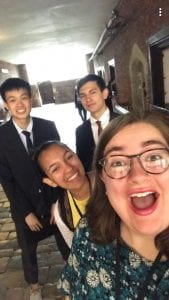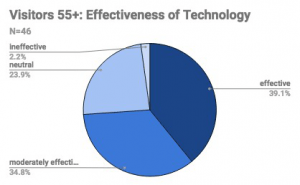Hampton Court: Tudor Kitchen Evaluation
Executive Summary
As a country with a rich history dating back thousands of years, the United Kingdom has one of the largest and most popular heritage sectors in the world. One of the leading organizations in this popular sector is the sponsor of this project, Historic Royal Palaces (HRP).
One of the palaces in HRP’s care, Hampton Court Palace (HCP), recently re-presented their Tudor Kitchens, implementing more boundary-pushing methods such as modern technology and live interpretation. This is part of HCP’s Core Story Project, a multi-year plan to “create a world-class, coherent visitor experience at Hampton Court Palace (“Core Story” 2017). The goal of this research project was to evaluate the re-presentation of the Tudor Kitchens and identify the implications for the Core Story Project and the planned re-presentation of the Tudor State Apartments at Hampton Court Palace.
Literature Review
Hampton Court Palace is just one small part of the UK’s enormous heritage sector. This sector attracts an abundance of visitors on a yearly basis, and plays a huge role in the United
Kingdom’s tourist economy. Nearly 4.5 million people visit HRP’s six properties on an annual basis (“2016/17 Annual Review” 2017), while 40 million people visit the UK heritages sites in total each year (Press Association 2016). The mission of the heritage industry is to preserve the world’s history, while conveying relevant information in an interesting and educational manner. Thus, in order to stay relevant, studying the behaviors, wants, and needs of industry guests is imperative.
Heritage sector sites, in an effort to preserve history, used plain and didactic methods; these included but were not limited to static signage, plaques, and maps. However, growing competition in the sector and changing guest expectations has caused reevaluation in the heritage sector, and a shift in focus towards innovative interpretation. Common practices in museum (and now heritage sector) evaluation include but are not limited to different forms of guest surveying and guest tracking (Bitgood & Shettel 1996).
Methodology
The project implemented evaluative methods in order to fully understand the guest experience, in an effort to achieve our goal. There were three main objectives in reaching said goal:
- Identify best practices and standards for interpretation in the heritage sector.
- Identify the goals and intended outcomes for the Core Story Project through on-site staff interviews.
- Assess visitor responses to the re-presentation and interpretation of the Tudor Kitchens. The first objective led us to go to heritage sites that are similar to Hampton Court Palace, in order to study their methods of interpretations; the sites were Ham House, Fulham Palace, and Windsor Castle. Additionally, we visited the National Gallery, in order to experience a different kind of museum. We observed primarily traditional interpretation methods at these locations, including costumeless docents instead of actors and signs instead of technology.
For the second objective, we first recorded what interpretation methods are being used at HCP, so we could compare them to what we found at other heritage sites. Additionally, in order to understand the hopes and expectations surrounding the Core Story Project, we conducted semi-structured interviews with HCP staff members. We were in extensive contact with two liaisons from Historic Royal Palaces: Catherine Buffrey, who is Head of Arts and Cultural Programming, and Aaron Manning, who is Creative Programming and Interpretation Manager..
We also interviewed Liam Stanley, an Operations Manager, and Richard Fitch, Historic Royal
Palace’s Kitchen Interpretation Coordinator.
The third objective included visitor tracking, exit surveys, and data analysis. We used the “pen-and-paper” method of tracking; the team had copies of the kitchen area blueprint, on which we traced the selected guest’s path and recorded dwell times. Additionally, upon a guest’s exit, a team member approached them with a mobile phone and asked them to take the exit survey upon the device. Questions were broken down into three sections: demographics, prior knowledge, and current experience. Following completion of data collection, Microsoft Excel and Qualtrics were employed for survey number analysis and dwell time analysis of tracks, respectively.
Findings & Analysis
Live Interpretation
We collected 160 tracks and 160 on-site surveys. Additionally, due to our staggered approach of collecting data in the morning, lunchtime, and late afternoon hours, we had sufficient sample representation from each day of the week and different times of day.
We found that guests enjoyed actors and live interpreters the most out of any method. For instance, 72.9% of survey-takers ranked the actors and live interpreters combined “effective” at conveying information, whereas the percentage of that answer for the other four categories of interpretation methods combined was only 50.9% (Figure 4.1).
Figure 4.1 Percentage of surveyed HCP guests who ranked live cookery team and outdoor actors combined “effective”, versus the percentage of guests who ranked all other methods combined “effective” (Campolieta, Galvan, Johnson, & Wu 2018)
Once we broke down specific responses to how interesting people found cooks vs. actors, we did find some discrepancies in guest opinion between the two interpretation methods. 61.8% of surveyed guests ranked the live cookery team “extremely interesting”, while only 50% of guests gave the outdoor actors this rank. Additionally, 17.4% of surveyed guests ranked the outdoor actors only “moderately interesting”, while only 11.8% of responses for the live cookery team were this (Figure 4.3). This is likely because the live cookery team, though they are dressed in period costume, are not actors and speak to guests in approachable modern English.
Technology
Though live interpretation had the vast majority of reviews in one answer, technology did not; technological interpretation garnered the most difference in reviews out of any method. Though 29.5% of surveyed guests answered that they found technology extremely interesting, a close 26.9% of guests were only moderately interested by the technology. This was discovered to
be an age discrepancy; all guests who ranked technology “ineffective” came from those in the 55 and older category, while over half of guests younger than 55 ranked technology effective, the highest rank possible (Figure 4.6).
Figure 4.6: Effectiveness of technology in guests 55+ (Campolieta, Galvan, Johnson, & Wu 2018)
Tracking Patterns
Tracking data unearthed a lot of similar trends among guests, such as dwell times. Visitors who entered from the back and front entrances spent approximately 9 minutes in the kitchens in total. Average time for visitors who used the side entrance was about 12 minutes. Audio guides also had an effect on the distribution of dwell times of guests. Visitors that entered from the side, 83.3% of whom had an audio guide with them, spent about 15% of their total time in the boiling house while visitors that used the other two entrances spent only 3% to 4% of their time in the same room. However, we did not find a clear distinction in overall dwell time between visitors who used audio guides in comparison to those who did not. There was only a 1% difference between the two in terms of total time spent in the kitchen. The most popular place for visitors is undoubtedly the fourth room (the final room in the great kitchens) which takes up around 40% of the total time, especially station 13 — the fireplace that single-handedly takes up 15% of the total time. Additionally, based on our exit surveys, this is the place where visitors most feel “they stepped back in time”.
Recommendations and Conclusion
The largest trend in our data was the extreme popularity of actors and live interpreters, amongst all different groups of guests. Therefore, we suggest HRP take this into account when making changes to methods at the Tudor apartments, and even in further improving the kitchens. Though the palace begins admitting visitors at 10am, the live cookery staff does not begin work until 11am. We suggest that the live cookery staff begin working at 10am, right when doors open, since they have such a big impact on the positivity of visitors about their time at HCP. Additionally, from our analysis of interpretation methods, we suggest that there be an actor with guests at all times on actor tours. The lack of guidance in the actor tour seemed to assume some semblance of guest familiarity with the palace, which many visitors do not have.
As for the Tudor apartments, we recommend that HCP have a mix of the in-character actors and the more approachable live interpreters. Though some guests have more open personalities suited for interacting with full-on actors, easy-to-talk-to costumed interpreters ensure that there is somebody that nearly every guest is comfortable speaking with. These people (the live interpreters in particular) should be present for the entire time Hampton Court is open to the public (10am-6pm), since they have proven to be such a crucial part of the HCP experience. Additionally, we suggest that HCP be strategic about where they place their actors and live interpreters, since our tracking data shows that people are often drawn to them and will walk in their direction.
A common comment that we got from the visitor survey were that people often “felt hungry” throughout the Kitchens. Since the cooks are already trained, we would recommend HRP to have the actors give out the made food to others through samples to bring the experience more to life. Additionally, throughout the kitchens there is a distinct lack of signage, to not take away from the authenticity. This, however, can lead to some confusion about what is allowed. We would like to recommend HCP to put up one or two signs before going into the kitchen that remind visitors that all objects are touchable and live interpreters are there for them to talk to. Overall, the re-presentations of the Tudor Kitchens have proven to be a success for Historic Royal Palaces. The artful implementation of technology, coupled with engaging live interpreters and actors, captivated guests and truly brought their experience to life. We hope that our visitor evaluation only goes to improve guest experience at Hampton Court Palace for years to come.





